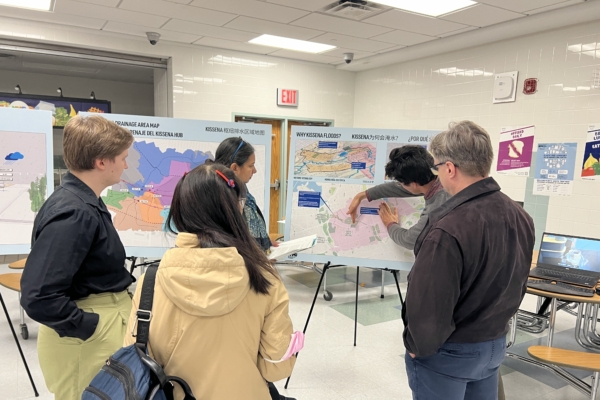New York City’s Department of Environmental Protection (DEP) held a community outreach event for the Kissena Cloudburst Hub project in Flushing on October 17. This project aims to address the flooding issues around Kissena Avenue by introducing short-term and long-term solutions to the residents and gathering feedback.
Cloudburst is a phenomenon where a large amount of rainfall pours down in a short period, causing the drainage system to overload and resulting in severe surface flooding. Around Kissena Park, significant floods occurred in 2021 and 2022, leading to three fatalities, multiple households being flooded, and substantial economic losses.
During the outreach event, the DEP used videos, display boards, handouts, official explanations, and Q&A sessions to introduce the Kissena Cloudburst Management Program to the residents. This program offers immediate solutions to manage flooding and plans for larger long-term strategies.
Data indicates that the flooding in the Kissena Park area is related to its lower topography and the region’s hydrological conditions and geological evolution. Kissena Park and its surrounding community were once along a stream called Kissena Creek.
Historical maps from 1873 and 1891 show that Kissena Creek was the main natural waterway in the area, flowing from Kew Gardens Hills and Pomonok marshes through various locations before merging with Flushing Creek. Although the creek is now “invisible,” its impact still lingers.
The New York City government, along with the Federal Emergency Management Agency (FEMA), is funding the Kissena Cloudburst Management Program. The DEP secured a $50 million grant from FEMA’s Building Resilient Infrastructure and Communities program, with the current estimated cost of the project being $80 million.
Areas most prone to flooding in the Kissena Cloudburst Zone include portions of 56th Ave. and Peck Ave. between 153rd St., the region from Rose Ave. to Quince Ave. near Kissena Ave., and 58th St. near Kissena Ave. These are the lowest points in terms of topography.
Due to the low-lying terrain of the area, Kissena Creek served as a collector of rainwater and groundwater, particularly during heavy rainfall periods. Addressing this issue requires multiple flood mitigation methods, including green infrastructure initiatives, cloudburst projects, Bluebelt systems, and sewer expansions.
Residents attending the outreach event, such as Ms. Zhang living on Rose Avenue in the flood-prone area, shared their feedback with the DEP officials. She emphasized the need for a focused approach in utilizing funds, suggesting prioritizing sewer expansions to effectively address the flooding issues in Kissena’s community.
In response to Ms. Zhang’s suggestion, DEP officials highlighted that sewer expansions are time-consuming and cannot provide immediate solutions to flooding problems. They are evaluating sewer and water storage projects as part of a comprehensive, long-term solution, complementing the short-term Kissena Cloudburst Management Program completion by 2028 and the recently finished rain garden at Booth Memorial and Kissena Blvd. in October 2024. The water storage project is in the conceptual planning stage.

